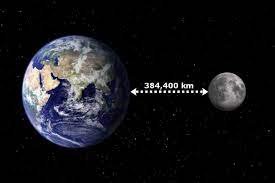Exploring the Vast Chasm: The Distance Between Earth and the Moon
The celestial dance between Earth and the Moon has fascinated humanity for millennia. From poets to astronomers, the allure of our closest cosmic neighbor has been a subject of curiosity and wonder. In this article, we will delve into the intricate details of the distance between Earth and the Moon, shedding light on its significance, historical context, and key takeaways for those preparing for government exams.
Why this News is Important:
Understanding Celestial Proximity
The proximity of the Moon to Earth is a fundamental concept in astronomy and space science. It affects not only the tides but also plays a crucial role in space exploration, satellite communication, and even our understanding of the universe.
Relevance in Government Exams
For students preparing for government exams, especially those aiming for positions in scientific research, space agencies, or related fields, a sound knowledge of celestial mechanics is indispensable. Questions about the Earth-Moon distance often appear in competitive exams, making it imperative to grasp this concept thoroughly.
Historical Context:
Ancient Observations
Throughout history, civilizations have observed the Moon’s phases and movements. Ancient Greeks like Aristarchus made early attempts to estimate the Earth-Moon distance using geometric methods.
Space Age Milestones
In the 20th century, with the advent of space exploration, accurate measurements of the Earth-Moon distance became possible. Missions like Apollo 11 not only put humans on the Moon but also allowed precise distance measurements.
Key Takeaways from this News:
| Serial Number | Key Takeaway |
|---|---|
| 1 | The average distance from Earth to the Moon is about 384,400 kilometers. |
| 2 | This distance is not constant; the Moon’s orbit is slightly elliptical, so it varies from around 363,300 km at its closest (perigee) to 405,500 km at its farthest (apogee). |
| 3 | The Earth-Moon distance is critical for understanding phenomena like tides, eclipses, and space missions. |
| 4 | The measurement of this distance has improved significantly over time, thanks to advancements in technology. |
| 5 | The concept of “astronomical unit” (AU) is often used, where 1 AU is the average distance from the Earth to the Sun (about 149.6 million kilometers), making it a useful reference for celestial distances. |
Important FAQs for Students from this News
Q1: How was the distance between Earth and the Moon first calculated?
A1: Ancient Greek astronomers, including Aristarchus, made early attempts to estimate this distance using geometric methods.
Q2: Why does the Earth-Moon distance vary?
A2: The distance varies due to the slightly elliptical shape of the Moon’s orbit, ranging from around 363,300 km at perigee to 405,500 km at apogee.
Q3: What is the relevance of the Earth-Moon distance in space exploration?
A3: Accurate knowledge of this distance is crucial for planning space missions and calculating fuel requirements.
Q4: What is an astronomical unit (AU), and how is it related to this topic?
A4: An AU is the average distance from Earth to the Sun (about 149.6 million km). It serves as a useful reference for celestial distances.
Q5: How has technology improved our understanding of the Earth-Moon distance?
A5: Advancements in space exploration and technology, such as laser ranging, have significantly improved our ability to measure this distance accurately.

